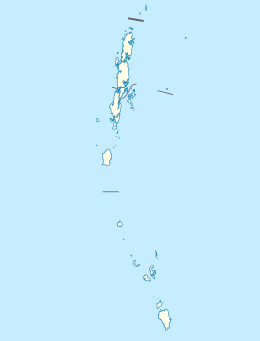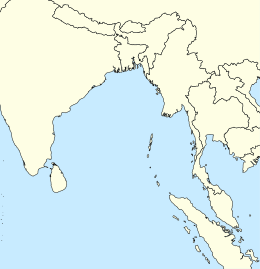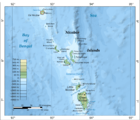Trinket Island
Trinket Island (sometimes spelled Trinkat or Trinkut) is one of the 24 islands that make up the Nicobar Islands chain, located in the northeast Indian Ocean between the Bay of Bengal and the Andaman Sea. It is located east of Kamorta Island.
 Trinket Island  Trinket Island | |
| Geography | |
|---|---|
| Location | Bay of Bengal |
| Coordinates | 8.08°N 93.58°E |
| Archipelago | Nicobar Islands |
| Adjacent bodies of water | Indian Ocean |
| Total islands | 2 |
| Major islands |
|
| Area | 12.25 km2 (4.73 sq mi)[1] |
| Length | 9.6 km (5.97 mi) |
| Width | 2.2 km (1.37 mi) |
| Coastline | 35.2 km (21.87 mi) |
| Highest elevation | 10 m (30 ft) |
| Administration | |
| District | Nicobar |
| Island group | Nicobar Islands |
| Subdivisions of India | Nancowry Subdivision |
| Taluk | Kamorta tehsil |
| Largest settlement | Trinket (pop. 2) |
| Demographics | |
| Population | 2[2] (2016) |
| Pop. density | 0.16/km2 (0.41/sq mi) |
| Ethnic groups | Hindu, Nicobarese |
| Additional information | |
| Time zone | |
| PIN | 744301 |
| Telephone code | 03192 |
| ISO code | IN-AN-00 |
| Official website | www |
| Literacy | 84.4% |
| Avg. summer temperature | 32.0 °C (89.6 °F) |
| Avg. winter temperature | 28.0 °C (82.4 °F) |
| Sex ratio | ♂/♀ |
| Census Code | 35.638.0002 |
| Official Languages | Hindi, English, Tamil Car (regional) |
Geography
Trinket has an area of 12.25 km², and a flat, low topography. Regional monsoons bring rains of 3,000 mm to 3,800 mm yearly.[3]
The island is surrounded by shallow waters and coral reefs,[4] which allow it to be approached by boat only during high tide.[3]
Administration
From 1869 until 1947 Trinket was part of Britain's Indian colonies. In 1947 it became part of the Dominion of India, and since 1950 of the Republic of India. Trinket is part of the Kamorta Tehsil, Nancowry subdivision of the Nicobars District, and part of the Andaman & Nicobar Islands state.
Since 1956 the Government of India has afforded protection to the native Nicobarese through a special legislation, the Andaman and Nicobar Protection of Aboriginal Tribes Regulation, which regulated entry to the islands.[3]
Demographics
Two early censuses of the island were conducted by the British administration in 1883 and 1901. The 1883 census revealed a population of 85 persons living in eight villages.[5] The 1901 census indicated an estimated population of 102 persons, spread between four and six villages, ruled by two chiefs.[5]
As of 2001, the Indian census had catalogued 436 persons living on Trinket in four villages: Trinket (population 244), Safebalu (pop. 127), Tapiang (pop. 42) and Hockcook (pop. 23).[6] Like most other islands in the Nicobar district, Trinket's population was almost exclusively ethnic Nicobarese.
Although, the 2011 Census of India indicated that the island had become uninhabited following the 2004 tsunami disaster,[7] as of the end of 2012 the island appeared to have been repopulated by a pair of returnees, living at the site of what had been Trinket village.[8]
Economy
From the fifteenth to the nineteenth centuries, trade with Trinket, as with the rest of the Nicobar Islands, was dominated by Indian, Arab, and European merchant fleets.[3]
Prior to the 2004 Indian Ocean earthquake, the island's populace was dependent on the outside world for many goods, including foodstuffs. Until the 1950s they exported whole coconuts and other forest products, but after the 1950s local production shifted toward exports of processed coconut, in the form of copra.[9] Those products were traded for imports such as rice, sugar, and clothes, which were used to supplement the local subsistence economy based on hunting and gathering, fishing, pig and chicken rearing, and household gardens.[10]
History
Trinket was officially made subject to the British Empire in 1869.[3] The island became part of sovereign India following Indian independence in 1947.
Effects of 2004 earthquake and tsunami
Physical effects
Like the other Nicobar and Andaman Islands, Trinket was devastated by tsunamis generated by the 2004 Indian Ocean earthquake. The island, which has a low and flat topography, was severely affected by the powerful waves and by earthquake-caused subduction of 1.5m to 1.75 m (4 ft 11 in to 5 ft 9 in),[11][12] suffering a reduction of its surface area from 14.6 km² down to 12.25 km².[13] Initial reports that the island had been split apart[14] were later confirmed by satellite imagery and onsite surveys.[11][15]
Human toll
On Trinket, the tsunami left 91 dead or disappeared[13] and the total devastation of the island's communities and economy. Shortly after the disaster, the entire remaining population of the island was evacuated to neighboring islands, principally Nancowry,[16] and Kamorta, where the Indian government built a resettlement village called Vikas Nagar.[8]
Repopulation of the island
By the end of 2012, only two people, both returnees, were reported to be living permanently on the island.[8]
Image gallery
 Map
Map
References
- "Islandwise Area and Population – 2011 Census" (PDF). Government of Andaman.
- Gopintah and his wife: the sole inhabitants of the island
- Lisa Ringhoffer, "Chapter 6: Comparing Local Transitions Across the Developing World", in L. Ringhofer, Fishing, Foraging and Farming in the Bolivian Amazon: On a Local Society in Transition, Springer, London (2010), ISBN 978-90-481-3486-1.
- K. Venkataraman, "Coral Reefs of India", in D. Hopley (Ed.), Encyclopedia of Modern Coral Reefs: Structure, Form and Process, Springer (Dordrecht, 2011). ISBN 978-90-481-2638-5.
- Lt. Col. Sir Richard C. Temple Bart (1903). 'Census of India, 1901. Volume III, The Andaman and Nicobar Islands. Report on the Census. Printed at the Government central Press. p. 10.
- Trinket Archived 4 February 2012 at the Wayback Machine, at Andaman & Nicobar Police website.
- Directorate of Census Operations, Andaman & Nicobar Islands (2011). "Census of India. Andaman & Nicobar Islands. Series-36, Part XII-B. District Census Handbook, Andaman & Nicobar Islands. Village and Town Wise Primary Census Abstract (PCA)." (PDF). Retrieved 11 September 2016.
- Zoyab, Alaphia. "A house for Mr. Gopinath, and a genset", The Hindu, 4 August 2012.(Entry retrieved 25 September 2013)
- Hobbes, Marieke. Figuring Rural Development: Concepts and Cases of Land Use, Sustainability and Integrative Indicators, Leiden University Press (2010), page 117.
- Marina Fischer-Kowalski, Simron J.Singh, Lisa Ringhofer, Clemens M. Grünbühel, Christian Lauk and Alexander Remesch. Sociometabolic regimes in indigenous communities and the crucial role of working time: A comparison of case studies. Alpen-Adria Universitat, Social Ecology Working Paper #121 (March 2010), ISSN 1726-3816. (Accessdate: 28 August 2016)
- M. G. Thakkar and Bhanu Goyal, "Historic submergence and tsunami destruction of Nancowrie, Kamorta, Katchall and Trinket Islands of Nicobar district: Consequences of 26 December 2004 Sumatra-Andaman earthquake", Current Science, Vol. 90, Issue 7 (10 April 2006), pages 989–994.
- Bagla, Pallava (28 January 2005). "After the Earth Moved". Science Now.
- Anup Kumar Das, "GIS based mapping of Tsunami induced Land Use/Cover change in Nancowry group of Islands, Andaman and Nicobar Islands", in OSTI Newsletter Archived 27 September 2013 at the Wayback Machine (published by the Ocean Science and Technology for Islands program of the Indian National Institute of Ocean Technology), Issue 10, October 2005, pages 2–4.
- "Fears Rise for Andaman Thousands", 'BBC News' website, Thursday, 30 December 2004.
- Image http://www.ircc.iitb.ac.in/~webadm/update/Issue1_2005/Images/Tsunami2.jpg Archived 18 July 2011 at the Wayback Machine in Indian Institute of Technology Bombay (ITTB) Industrial Research and Consultancy Centre (IRRC), Update newsletter, issue 1 of 2005.
- George Weber (2005), Earthquake and Tsunami: Maps, charts and statistics Archived 2 August 2012 at the Wayback Machine, chapter 4 Archived 20 August 2008 at the Wayback Machine; published online at "George Weber's LONELY ISLANDS: THE ANDAMANESE; an on-line Documentation on the Andamanese and other Negrito people, and their relationship to the earliest migrations of modern humans; incorporating the web-site of the Nicobar Association" Archived 21 July 2013 at the Wayback Machine website.
- Saini, Ajay (3 March 2017). "The islanders who don't want to return". The Hindu. Retrieved 13 June 2017.
